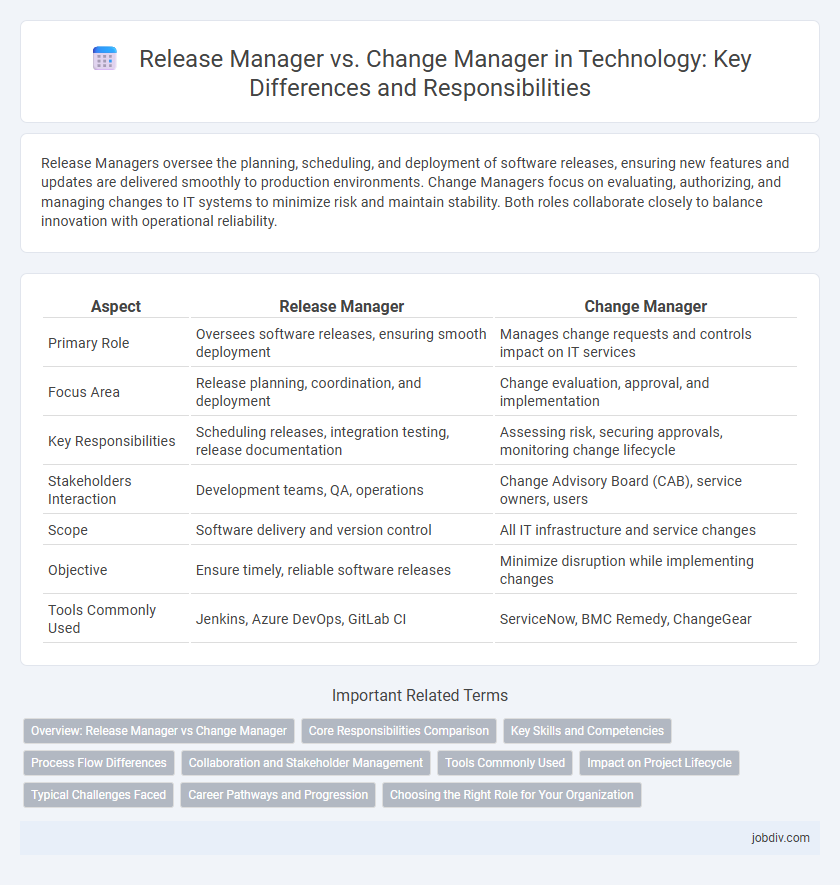Release Managers oversee the planning, scheduling, and deployment of software releases, ensuring new features and updates are delivered smoothly to production environments. Change Managers focus on evaluating, authorizing, and managing changes to IT systems to minimize risk and maintain stability. Both roles collaborate closely to balance innovation with operational reliability.
Table of Comparison
| Aspect | Release Manager | Change Manager |
|---|---|---|
| Primary Role | Oversees software releases, ensuring smooth deployment | Manages change requests and controls impact on IT services |
| Focus Area | Release planning, coordination, and deployment | Change evaluation, approval, and implementation |
| Key Responsibilities | Scheduling releases, integration testing, release documentation | Assessing risk, securing approvals, monitoring change lifecycle |
| Stakeholders Interaction | Development teams, QA, operations | Change Advisory Board (CAB), service owners, users |
| Scope | Software delivery and version control | All IT infrastructure and service changes |
| Objective | Ensure timely, reliable software releases | Minimize disruption while implementing changes |
| Tools Commonly Used | Jenkins, Azure DevOps, GitLab CI | ServiceNow, BMC Remedy, ChangeGear |
Overview: Release Manager vs Change Manager
Release Managers oversee the planning, scheduling, and deployment of software releases, ensuring smooth delivery and minimal disruption to users. Change Managers focus on evaluating, authorizing, and implementing changes within IT systems to mitigate risks and maintain system integrity. Both roles collaborate closely to balance rapid innovation with operational stability in technology environments.
Core Responsibilities Comparison
Release Managers oversee the planning, scheduling, and deployment of software releases to ensure smooth and timely delivery across environments. Change Managers focus on evaluating, approving, and coordinating changes to IT systems, prioritizing risk reduction and business continuity. Both roles collaborate to align release activities with change control processes, optimizing software delivery and minimizing disruptions.
Key Skills and Competencies
Release Managers excel in coordinating software deployment, requiring strong project management, version control expertise, and risk assessment skills to ensure smooth releases. Change Managers focus on managing organizational change, emphasizing communication, stakeholder engagement, and impact analysis to facilitate adoption. Both roles demand problem-solving abilities and collaboration but differ in operational scope, with Release Managers concentrating on technical delivery and Change Managers on people-centric transitions.
Process Flow Differences
Release Managers coordinate software deployment processes ensuring version control, scheduling, and environment readiness, while Change Managers oversee the approval and risk assessment of changes to minimize disruption. The Release Manager's process flow emphasizes build integration, deployment automation, and rollback plans, contrasting with the Change Manager's focus on stakeholder communication, change categorization, and impact analysis. Both roles intersect in managing deployment windows, but diverge in execution stages where Release Managers handle technical delivery and Change Managers enforce governance protocols.
Collaboration and Stakeholder Management
Release Managers ensure smooth deployment of software updates by coordinating cross-functional teams, aligning timelines, and managing risks, whereas Change Managers focus on minimizing disruptions through stakeholder engagement, communication plans, and training. Collaboration between both roles fosters seamless integration of new releases while addressing user adoption and organizational readiness. Effective stakeholder management involves transparent communication, managing expectations, and aligning objectives to support continuous delivery and change resilience.
Tools Commonly Used
Release Managers commonly utilize tools like Jenkins, Azure DevOps, and GitLab CI/CD for automating deployment pipelines and managing software releases, ensuring seamless integration and delivery. Change Managers often rely on IT Service Management (ITSM) platforms such as ServiceNow, BMC Remedy, and Jira Service Management to track, approve, and document changes, maintaining regulatory compliance and minimizing risks. Both roles may use collaboration tools like Slack and Confluence to coordinate teams and document procedures, enhancing transparency throughout the software development lifecycle.
Impact on Project Lifecycle
Release Managers coordinate software deployment schedules to ensure smooth transitions and minimize downtime, directly influencing project delivery timelines and quality assurance. Change Managers oversee the evaluation and approval of modifications to project scope or systems, reducing risks of disruptions by maintaining control over changes throughout the project lifecycle. Both roles collaboratively enhance project stability, with Release Managers driving execution phases and Change Managers managing governance and risk mitigation.
Typical Challenges Faced
Release Managers often face challenges in coordinating cross-functional teams to ensure timely software deployment while minimizing downtime and technical issues. Change Managers typically struggle with resistance to change, balancing risk mitigation with agility, and aligning changes with business objectives and compliance requirements. Both roles require effective communication and detailed documentation to manage complex processes and maintain system stability during transitions.
Career Pathways and Progression
Release Managers typically progress from roles in software development or project management, advancing toward senior IT leadership positions such as IT Program Manager or DevOps Director by mastering deployment strategies and release automation. Change Managers often begin their careers in business analysis or IT service management, moving up to roles like IT Service Manager or Business Change Director by specializing in change control processes and stakeholder communication. Both pathways reward expertise in risk assessment, process optimization, and cross-functional collaboration, with Release Managers emphasizing technical release coordination and Change Managers focusing on organizational impact and adoption.
Choosing the Right Role for Your Organization
Selecting the right role between a Release Manager and a Change Manager depends on your organization's primary focus--Release Managers specialize in coordinating software deployments and ensuring smooth delivery pipelines, while Change Managers concentrate on minimizing business disruptions through controlled change implementations. Evaluating factors such as the scale of software releases, frequency of updates, and organizational risk tolerance helps determine which role better supports your goals. Implementing both roles can be beneficial in complex environments, but aligning responsibilities clearly enhances operational efficiency and stakeholder communication.
Release Manager vs Change Manager Infographic

 jobdiv.com
jobdiv.com